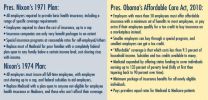(Press-News.org) ANN ARBOR, Mich. -- Few people today would dare call President Richard Nixon a radical liberal. But 44 years ago, he proposed a health plan that went far beyond what today's Affordable Care Act includes. After the first plan failed, he did it again three years later.
And just like today's heated rhetoric from opponents of the ACA, also called "Obamacare" after the president who introduced it, Nixon's plans were met with inflamed opposition from the other party.
In a new article in the journal Pediatrics, a team from the Child Health Evaluation and Research Unit at the University of Michigan Medical School compares the reality, and the rhetoric, of two efforts to improve the nation's health by reducing the number of people who lack health insurance.
"It's not that one is right and one is wrong," says author Gary Freed, M.D., MPH, a U-M pediatrician and health policy researcher. "But more that this is a chance to address the appropriate place of political rhetoric when it comes to improving public health, and the dangers of elevating blind partisanship over meaningful debate about important issues for our nation's health."
Looking at this comparison of the plans, Freed says, it's easy to see that Nixon's proposals were far more "liberal" than what passed under the Affordable Care Act during President Obama's first term. Yet, he notes, the rhetoric directed against the ACA - as "a radical liberal plan," "socialized medicine" and a "job killer" - seeks to paint the law in extremely inflammatory tones.
At the time of Nixon's proposals, those seeking a single-payer plan, led by Senator Ted Kennedy, scoffed and said that his plans did not go far enough. The Democrats' early-70s health proposal was far more liberal than anything the party has proposed in recent times, and they heaped scorn on the Republican plan.
Freed notes that the approach Nixon took, which preserved the insurance industry's role in health care, would have covered more people than the ACA does.
At the time, Nixon put forth this rationale for his plan: "Those who need care most often get care least. And even when the poor do get service, it is often second rate...This situation will be corrected only when the poor have sufficient purchasing power to enter the medical marketplace on equal terms with those who are more affluent." Employees around the nation supported Nixon's plan as a welcome alternative to the single-payer proposals.
Both the Nixon plans and the ACA were driven by a desire to provide health coverage for the uninsured segment of the American people, says Freed, and to keep health care costs from continuing to rise out of control.
"It would be a very different country today if the Nixon plan had passed," says Freed. "Instead, we had 30 more years with one-third of the population uninsured," even after the expansion of Medicaid to cover near-poor children in the late 1990s.
"We need to put health care in a historical perspective, and not go to extremes for political purposes," says Freed. "I would hope this history will help policy makers think about what the policy is trying to accomplish for the American people, and not turn a blind eye to proposals simply because they're proposed by one party or the other."
Freed, who is the Percy and Mary Murphy Professor of Pediatrics and Community Health at the U-M Medical School, is also a professor of Health Management and Policy at the U-M School of Public Health and a visiting professor at the University of Melbourne, Australia. He is a member of the U-M Child Health Evaluation and Research unit and the U-M Institute for Healthcare Policy and Innovation.
Freed and co-author Anup Das note these key elements of the two presidents' plans:
President Richard Nixon's National Health Strategy (1971)
All employers required to provide basic health insurance, including a range of specific coverage requirements
Employees required to share the cost of insurance, up to a cap
Insurance companies can only vary benefit packages to an extent
Special insurance programs at reasonable rates for self-employed and others
Replace most of Medicaid for poor families with a completely federal plan open to any family below a certain income level; cost-sharing rises with income.
Nixon's Comprehensive Health Insurance Plan (1974)
All employers must insure all full-time employees, with employee cost-sharing up to a cap, and federal subsidies to aid employers.
Replace Medicaid with a plan open to anyone not eligible for employee health insurance or Medicare, as well as those who can't afford their coverage
President Barack Obama's Affordable Care Act (2010)
Employers with more than 50 employees must offer affordable insurance with a minimum set of benefits to most employees, or pay extra if their employees qualify for a tax credit to buy insurance on a marketplace instead.
Smaller employers can buy through a special program, and smallest employers can get a tax credit.
"Affordable" coverage is that which costs less than 9.5 percent of household income. Subsidies and tax credits available to many.
Medicaid expanded by offering states funding to cover individuals earning up to 133 percent of poverty level (fully at first then tapering back to 90 percent over time).
Minimum package of insurance benefits for all newly eligible individuals.
Pays providers equal rates for caring for Medicaid and Medicare patients
INFORMATION:
Reference: Pediatrics ePrint ahead of publication: DOI: 10.1542/peds.2015-1122, Volume 136, number 2, August 2015 END
This news release is available in German.
Slugs and other invertebrates provide essential public transport for small worms in the search for food, according to research published in the open access journal BMC Ecology.
Nematode worms (including Caenorhabditis elegans) are around a millimeter long and commonly found in short-lived environments, such as decomposing fruit or other rotting plant material. The worms face a high level of unpredictability in these environments as temperature and food availability fluctuate, and frequently need to move to new locations. ...
Treatment could save the NHS £3.1 billion every year
More than 200,000 patients in the UK suffer with chronic wounds
Healing time can be reduced by a third
Healing times for skin ulcers and bedsores can be reduced by a third with the use of low-intensity ultrasound, scientists from the University of Sheffield and University of Bristol have found.
Researchers from the University of Sheffield's Department of Biomedical Science discovered the ultrasound transmits a vibration through the skin and wakes up cells in wounds helping to stimulate and accelerate the healing ...
When two different sized galaxies smash together, the larger galaxy stops the smaller one making new stars, according to a study of more than 20,000 merging galaxies.
The research, published today, also found that when two galaxies of the same size collide, both galaxies produce stars at a much faster rate.
Astrophysicist Luke Davies, from The University of Western Australia node of the International Centre for Radio Astronomy Research (ICRAR), says our nearest major galactic neighbour, Andromeda, is hurtling on a collision course with the Milky Way at about 400,000 ...
As the world's leaders gather in Addis Ababa, Ethiopia, for the Financing for Development Conference [1], a study published in The Lancet demonstrates that a new approach is needed for classifying funding that reflects the function the funding serves, rather than the specific disease or country. The study is the first in-depth assessment of how donor funding is spent on global versus country-specific functions of health [2].
The paper also presents an expanded definition of official development assistance (ODA) for health, which is used to identify important underfunded ...
As experts debate the slow response to the Ebola outbreak in West Africa and call for better international coordination, a new analysis estimates that $22 billion was spent on global health aid in 2013, yet only a fifth of this went toward such global imperatives as research on diseases that disproportionally affect the poor, outbreak preparedness and global health leadership.
The analysis, by Dean Jamison, PhD, a global health economist at UC San Francisco (UCSF); Lawrence Summers, PhD, a former US Treasury Secretary now at Harvard University; and researchers at SEEK ...
ORLANDO, FL - Surgeries related to overuse elbow injuries, i.e. Tommy John Surgery, are more common among youth athletes than previously believed, according to research presented today at the American Orthopaedic Society for Sports Medicine's (AOSSM) Annual Meeting in Orlando, Florida.
"Our results showed that 15-19 year-olds accounted for 56.7 percent of the Ulnar Collateral Ligament Reconstruction (UCLR) or Tommy John surgeries performed in the U.S. between 2007-2011. This is a significant increase over time with an average increase of 9.12 percent per year," said lead ...
ORLANDO, FL - Athletes who've had lower extremity surgeries before going on to play in college, might be at a higher risk for another surgery independent of gender and sport, say researchers presenting their work today at the American Orthopaedic Society for Sports Medicine's (AOSSM) Annual Meeting in Orlando, FL.
"This is the first study to look at the relationship between precollegiate surgery and future injury requiring surgery in collegiate athletes. Our results suggest that athletes injured before college might be left with a functional deficit that puts them at ...
Nutrition support professionals who are well-versed in proper documentation of malnutrition diagnoses in hospital patients can help ensure that hospitals receive maximum funding for patient care according to a new review.
The review, recently published in Nutrition in Clinical Practice (NCP), a peer-reviewed, interdisciplinary journal of the American Society for Parenteral and Enteral Nutrition (A.S.P.E.N.) that publishes articles about the scientific basis and clinical application of nutrition and nutrition support, found that proper documentation and coding of malnutrition ...
ORLANDO, FL - Patients treated surgically for a hamstring rupture demonstrated better results than those treated only with therapy, according to a study presented today at the American Orthopaedic Society for Sports Medicine's (AOSSM) Annual Meeting in Orlando, FL.
"Overall, patients in this study treated with surgery had a trend towards better lower extremity function as well as a higher likelihood of returning to re-injury activities than those treated non-surgically," commented corresponding author Joshua Olsen, MD, from the New England Baptist Hospital. "Most notably, ...
ORLANDO, FL - Outcomes following the arthroscopic repair of rotator cuff tears in older athletes appears to be successful a majority of the time, according to research presented today at the American Orthopaedic Society for Sports Medicine's (AOSSM) Annual Meeting in Orlando, Florida.
"Seventy-seven percent of our patients who had an arthroscopic repair of a full thickness rotator cuff tear, were able to return to their sport at a similar level of intensity," said lead author, Peter Millett, MD, MSc, from the Steadman Philippon Research Institute in Vail, Colorado.
Forty-nine ...



